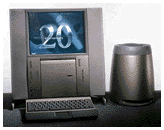No rumors this time, neither true nor imaginary. The powers
that be at Low End Mac are letting me write
an editorial.
This coming May, it will be three years since Steve Jobs showed the
world the Bondi Blue Wonder - the original iMac. It was
perhaps the most revolutionary new computer since the original 1984
Macintosh. In a world of beige boxes with separate monitors, the
first Mac and the iMac had the audacity to be different, to
include a crisp monitor as part of the computer itself.
Now this wasn't really a radically new concept. The Commodore PET of
1976 did it, but earlier all-in-one designs usually included the
keyboard as well. Apple certainly perfected the concept.
Ever since the iMac was unveiled, there have been rumors of a 17"
iMac. Some have claimed there are 17" iMac prototypes at 1 Infinite
Loop - something I have no doubt is true. And I'm equally confident the
size and weight make it less iMac-like than Steve Jobs, Apple's
marketing department, and the buying public would find acceptable.
Seriously, if Apple thought there really was a market for a 17"
iMac, you can believe they would have introduced it sometime in the
past few years. Their failure to do so tells us we shouldn't ever
expect it.
If that's the case, and it certainly does make a lot of sense, where
can the iMac go from here?
Apple has made it a bit smaller, a bit lighter, and a bit less
expensive. This year we finally have iMacs with recordable
drives inside. And the new monitors are even better than the old
ones, supporting 1024 x 768 reasonably well.
The iMac has grown faster: by steps it has gone from 233 MHz to 266,
then 333, then 400, then 500, and now 600 MHz. The new models are so
much faster than the originals, Apple may find a market selling faster
iMacs to those with the earlier revisions.
The trend to greater speed, despite the incompetence of
Motorola on the G4, is a given. The PowerPC 750Cx at the heart of the
fastest iMac is designed for speeds up to 700 MHz, so we can
expect another iMac speed improvement sometime after the G4 breaks 800
MHz.
But faster processors, bigger hard drives, and more memory are more
of the same. After almost three years, the same can be said of the
iMac, even if you can get it in flower power and dalmatian blue these
days. The iMac design has become pedestrian; it's time to
replace it.
Apple pointed the way in May 1997 when they celebrated the 21st
anniversary of their incorporation (on April 1, 1976) by introducing the Twentieth Anniversary
Macintosh (TAM). It was an expensive ($7,500!) tour de force of
technology and design. Even today it doesn't look the least bit
dated.
by introducing the Twentieth Anniversary
Macintosh (TAM). It was an expensive ($7,500!) tour de force of
technology and design. Even today it doesn't look the least bit
dated.
Picture Apple's 15" flat panel display instead of the TAM's 12.1"
800 x 600 screen. Put the speakers below the display, as the iMac does.
Put the Cube's slot-loading vertical drive behind the screen. In
fact, put all the computer's insides behind the screen.
Add a keyboard, mouse, and optional subwoofer, and you've just
replaced the iMac with something under 4" deep. That's what I
envision eventually replacing the iMac.
For the short term, the iMac will have a real price advantage. Flat
panel displays aren't cheap, but they are coming down in price. Best of
all, every part of the next generation consumer Mac comes from today's
models; other than the case, there would be no unique parts.
The flat Mac would cost less to ship, since it would be far lighter
than the iMac. It would be easier for stores to stock, since the box
would be much smaller than the iMac's.
But most of all, it would be different. Give it a year or two of
overlap with the iMac line, then drop the iMac completely.
When it comes right down to it, this could kill the markets for
the Cube and the 15" flat panel display. Apple could wind up
with two desktop models again, which would certainly simplify
things.
Will it happen? Undoubtedly. When? My guess, and it's nothing more
than that, is anywhere between April 1, 2001 (Apple's 25th anniversary)
and May 25, 2001 (the last day of the Worldwide Developers
Conference).
The flat Mac won't be positioned as an iMac replacement or a Cube
replacement, but that's what it will become over time. It will also be
the compact hub of our digital lifestyle, a computer at home in
the dorm room, family room, and even the office.
- Anne Onymus


 by introducing the
by introducing the 
